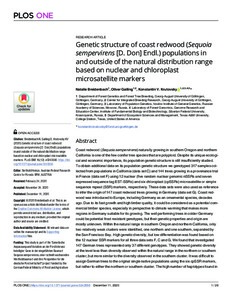Genetic structure of coast redwood (Sequoia sempervirens [D. Don] Endl.) populations in and outside of the natural distribution range based on nuclear and chloroplast microsatellite markers
Скачать файл:
URI (для ссылок/цитирований):
https://elib.sfu-kras.ru/handle/2311/137949Автор:
Breidenbach Natalie
Gailing Oliver
Krutovsky Konstantin
Дата:
2020Журнал:
PLoS ONEКвартиль журнала в Scopus:
даКвартиль журнала в Web of Science:
даСтатья из журнала.
Аннотация:
Coast redwood (Sequoia sempervirens) naturally growing in southern Oregon and northern California is one of the few conifer tree species that are polyploid. Despite its unique ecological and economic importance, its population genetic structure is still insufficiently studied. To obtain additional data on its population genetic structure we genotyped 317 samples collected from populations in California (data set C) and 144 trees growing in a provenance trial in France (data set F) using 12 nuclear (five random nuclear genomic nSSRs and seven expressed sequence tag EST-SSRs) and six chloroplast (cpSSRs) microsatellite or simple sequence repeat (SSR) markers, respectively. These data sets were also used as reference to infer the origin of 147 coast redwood trees growing in Germany (data set G). Coast redwood was introduced to Europe, including Germany as an ornamental species, decades ago. Due to its fast growth and high timber quality, it could be considered as a potential commercial timber species, especially in perspective to climate warming that makes more regions in Germany suitable for its growing. The well performing trees in colder Germany could be potential frost resistant genotypes, but their genetic properties and origin are mostly unknown. Within the natural range in southern Oregon and northern California, only two relatively weak clusters were identified, one northern and one southern, separated by the San Francisco Bay. High genetic diversity, but low differentiation was found based on the 12 nuclear SSR markers for all three data sets F, C and G. We found that investigated 147 German trees represented only 37 different genotypes. They showed genetic diversity at the level less than diversity observed within the natural range in the northern or southern cluster, but more similar to the diversity observed in the southern cluster. It was difficult to assign German trees to the original single native populations using the six cpSSR markers, but rather to either the northern or southern cluster. The high number of haplotypes found in the data sets based on six cpSSR markers and low genetic differentiation based on 12 nuclear SSRs found in this study helps us study and better understand population genetic structure of this complex polyploid tree and supports the selection of potential genotypes for German forestry. © 2020 Breidenbach et al. This is an open access article distributed under the terms of the Creative Commons Attribution License, which permits unrestricted use, distribution, and reproduction in any medium, provided the original author and source are credited.

